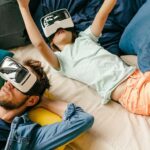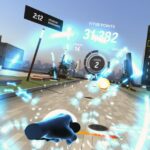Locomotion describes how people move through virtual environments and is one of the core design features of all VR applications. Providing a comfortable locomotion experience is essential for creating immersive and enjoyable apps that allow people to engage in a world that is far more vast than the physical space they occupy.

Our new locomotion guide provides the building blocks to better understand locomotion in VR applications, as well as best practices and techniques to maximize the end user experience and minimize discomfort.
Within this guide, we introduce and explore the following topics:
- Common Types of Artificial Locomotion
- Artificial locomotion describes those methods of locomotion that don’t depend on physically moving around the playspace. This section outlines the most common types of artificial locomotion, such as world pulling, scripted movement, avatar movement, and more.
- Controlling Artificial Locomotion
- An overview of the many controller and input methods to drive artificial locomotion. This section outlines the many types of thumbstick driven locomotion, teleport controls, and considerations for seated control systems.
- Locomotion Design Challenges
- When designing a VR locomotion system, there are many scenarios to consider. This guide identifies and provides guidance for many of these, which can enable people to climb, crawl, jump, and peek over ledges.
- Comfort and Usability Issues
- The foundation of any well designed locomotion system is based on comfort and usability. This section discusses the way our sensory systems respond to VR, techniques for improving comfort, and other usability issues such as space limitations and fatigue.
- Techniques and Best Practices
- This section builds upon the information of the previous sections to discuss a number of specific locomotion techniques that have been found to be effective at improving comfort, usability and accessibility.
While most of the material in this guide is geared towards building first-person VR applications, many of the techniques will be useful in 3rd person applications as well.
The following condensed excerpt from our locomotion guide introduces core types of virtual locomotion and offers examples and best practices for your consideration.
Core Types of Virtual Locomotion: Physical and Artificial
The way people move through a virtual environment is usually referred to as Virtual Locomotion. We move through the virtual world, or the virtual world moves around us. Sometimes, both at the same time.
When the camera matches the physical movement of the headset, and the perspective of the viewer in the virtual world matches the exact movement of the headset, we refer to this as “Physical Locomotion”. When the camera moves independently of the position of the headset, we refer to this as “Artificial Locomotion”.
Physical Locomotion
Physical locomotion is when movement in the virtual world is controlled by your movement in the physical world. For example, you walk, turn, or move through the virtual world by walking, turning, and moving in the real/physical world. With physical locomotion, the camera movement in the virtual world should match the exact movement of the physical headset.
Even if your app is not designed for physical locomotion, it’s important to plan for what happens when people physically move in the real world. For instance, what if a user takes a step in physical space or leans forward while sitting? Would this move the virtual camera into solid geometry like walls, decorations or characters in VR? Planning for these scenarios will solve many potential comfort, performance, and usability challenges as you design your locomotion system.
Artificial Locomotion
Artificial locomotion is when movement in the virtual world does not directly correspond to physical movement. For example, when you walk, turn, or move through the virtual world in response to controller inputs, such as pushing a thumbstick.
The most common use of artificial locomotion is to make it possible for people to move through virtual environments that are larger than their physical playspace; however, there are many other scenarios where it is necessary or useful to use artificial locomotion. For example, movement can sometimes be controlled by, or in response to, the environment, like an elevator or a roller coaster.
Games that are designed primarily for physical locomotion can usually benefit from supporting artificial locomotion because it will make it possible for people with limited space or mobility issues to experience the content. Unless physical locomotion is core to the design, it is recommended to support artificial locomotion to make the application as accessible as possible.

Learn more VR locomotion concepts and techniques in our full locomotion guide here. If you have any questions, feel free to leave a comment or join the conversation in our forum.
Quelle:
https://developer.oculus.com/blog/now-available-vr-locomotion-design-guide/


